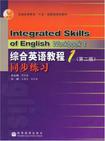综合英语教程1
出版时间:2005-8 出版社:高等教育出版社 作者:邹为诚总主编 页数:181
前言
《综合英语教程(第二版)同步练习》是《综合英语教程》(第二版)的配套练习用书,是教育部“十五”国家级规划教材建设的子项目之一。全套书共4册(配有录音磁带),供学习《综合英语教程》(第二版)的学生自主学习使用。 自主学习是课堂教学的重要补充,大量的语言练习是在自主学习中完成的。本书以“为学生提供课外反复操练语言的机会”为指导思想,以《综合英语教程》(第二版)的内容为基础,但又不限于此,力求在巩固教材所学内容的同时,扩大学生在听、说、读、写等4方面的训练,并给学生以必要的学习策略指导和课外阅读指导。因此,本书既是配合《综合英语教程》(第二版)学习的好伴侣,也是学生提高英语水平和学习能力的好帮手,还是学生应考英语专业四级考试(TEM4)的必备用书。《综合英语教程l(第二版)同步练习》共15个单元,每个单元由5部分组成:第一部分,语法和结构练习(PartlVocabularyandStructure)。此部分主要针对教材中没有重点练习的词、句等语言点,是教材内容学习的补充。建议学生反复练习,直到熟练掌握词、句的用法和特点为止。第二部分,听力练习(Pan2L,isteningComprehension)。此部分的练习包括正误判断、听写、复述等形式的听力训练活动。建议学生进行反复操练,直到掌握为止。第三部分,学习技能训练(Part3trainingofIgamingStrategies)。此部分的主要内容是指导学生使用英语词典。通过练习,学生可在以下4个方面有所收获: 1.提高检索词语的能力; 2.提高理解英语的能力, 3.丰富语言细节的知识,如:惯用法、搭配、重音位置等; 4.获得更准确的词语意义,即通过理解词语的英语释义,学生能更准确地把握词语的意义。 第四部分,英语专业四级考试适应性练习(Part4ExercisesforTEM4)。此部分是根据英语专业四级考试要求而设计的练习题,不仅包括语法词汇、听力理解、阅读理解和写作等练习,还有口试练习题。学生可在日常学习中逐渐熟悉考试要求,进行自我训练,并在练习性测试中学会控制时间。 第五部分,课外阅读指导(Part5GuidelinesforExtraReading)。大量阅读是自主学习中的一项重要活动。为此,本部分为学生推荐了一些适合他们水平的经典文学作品,并配有思考题。学生可有针对性地阅读,以提高语言水平和文学鉴赏能力。 《综合英语教程1(第二版)同步练习》是学好《综合英语教程1》(第二版)的必备辅学用书,它可以帮助学生巩固所学内容,开阔知识视野,提高学习能力。 参加《综合英语教程1(第二版)同步练习》编写工作的学校有华东师范大学外语学院、华南师范大学南海学院、湖北襄樊学院外语系、西北师范大学外语学院和山东曲阜师范大学外语学院。 若书中有不当之处,敬请读者为我们提出宝贵意见。
内容概要
《综合英语教程同步练习》是(《综合英语教程》(第二版)的配套练习用书,是教育部“十五”国家级规划教材建设的子项目之一。全套书共4册(配有录音磁带),供学习《综合英语教程》(第二版)的学生自主学习使用。 《综合英语教程同步练习》以《综合英语教程》(第二版)的内容为基础,但又不限于此,力求在巩固教材所学内容的同时,扩大学生在听、说、读、写等4方面的训练,并给学生以必要的学习策略指导和课外阅读指导。 《综合英语教程1(第二版)同步练习》共15个单元,每个单元由5部分组成:1.语法和结构练习(Part1VocabularyandStructure);2.听力练习(Part2ListeningComprehension);3.学习技能训练(Part3TrainingofLearningStrategies);4.英语专业四级考试适应性练习(Part4ExercisesforTEM4);5.课外阅读指导(Part5GuidelinesforExtraReading)。
书籍目录
I my First JobPart 1 Vocabulary and StructurePart2 Listening ComprehensionPart 3 Training of Learning StrategiesPart4 Exercises forTEM4Part5 Guidelines for Extra Reading2 Amerecan homes and british homesPart 1 Vocabulary and StructurePart 2 Listening ComprehensionPart 3 Training of Learning StrategiesPart 4 Exercises for TEM 4Part 5 Guidelines for Extra Reading3 What is in a NamePart 1 Vocabulary and StructurePart2 Listening ComprehensionPart 3 Training of Learning StrategiesPart 4 Exercises for TEM 4Part5 Guidelines for Extra Reading4 Doing Away with the Kings EnglishPart 1 Vocabulary and StructurePart2 Listening ComprehensionPart 3 Training of Learning StrategiesPart 4 Exercises for TEM 4Part 5 Guidelines for Extra Readinq5 England as seen by americansPart 1 Vocabulary and StructurePart 2 Listening ComprehensionPart 3 Training of Learning StrategiesPart 4 Exercises for TEM 4Part 5 Guidelines for Extra Reading6 The first day at schoolPart 1 Vocabulary and StructurePart 2 Listening ComprehensionPart 3 Training of Learning StrategiesPart 4 Exercises for TEM 4Part 5 Guidelines for Extra Reading7 computersPart 1 Vocabulary and StructurePart 2 Listening ComprehensionPart 3 Training of Learning StrategiesPart 4 Exercises for TEM 4Part 5 Guidelines for Extra Reading8 The missing monarchsPart 1 Vocabulary and StructurePart 2 Listening ComprehensionPart 3 Training of Learning StrategiesPart 4 Exercises for TEM 4Part 5 Guidelines for Extra Reading9 The risks of liftPart 1 Vocabulary and StructurePart 2 Listening ComprehensionPart3 Training of Learning StrategiesPart 4 Exercises for TEM 4Part5 Guidelines for Extra Reading10 Words can give youPowerPart1 Vocabulary and StructurePart 2 Listening ComprehensionPart3 Training of Learning StrategiesPart4 Exercises forTEM4Part5 Guidelines for Extra Reading11 The transactionPart 1 Vocabulary and StructurePart2 Listening ComprehensionPart3 Training of Learning StrategiesPart4 Exercises forTEM4Part5 Guidelines for Extra Reading12 The message behind the smilePart 1 Vocabulary and StructurePart2 Listening ComprehensionPart3 Training of Learning StrategiesPart 4 Exercises for TEM 4Part5 Guidelines for Extra Reading13 A Delightful VillagePart 1 Vocabulary and StructurePart 2 Listening ComprehensionPart3 Training of Learning StrategiesPart4 Exercises forTEM4Part5 Guidelines for Extra Reading14 The mystery of the white gardeniaPart 1 Vocabulary and StructurePart 2 Listening ComprehensionPart 3 Training of Learning StrategiesPart 4 Exercises for TEM 4Part 5 Guidelines for Extra Reading15 For or against smoking inPublidPlacesPart 1 Vocabulary and StructurePart 2 Listening ComprehensionPart 3 Training of Learning StrategiesPart 4 Exercises for TEM 4Part 5 Guidelines for Extra Readingkeys and audio scripts
章节摘录
In June 1997 a great financial crisis burst out in Thailand. It is because Thailand haspoured nearly 30 percent of its total loans into real estate market since 1992 and most of theloans have failed to be taken back by now. It is not strange that investments in real estates areconsidered to be full of risks. But what on earth is risk? In Longman Dictionary"risk" is defined as a danger orsomething that may have a bad result. But this definition is not comprehensive. Risk at leastincludes two sides: danger and safety. In fact the nature ofrisk is the degree of safety andsecurity. The lower the degree is, the more dangerous it is. If one opens the dictionary, onecan easily find many words that express the similar idea of risk, e.g. danger, hazard and crisis.All these words show different levels of safety under different circumstances. Risks exist everywhere. When one goes to the market, for example, he will have to takecare whether the food is fresh or not. Here exists risk. Risks are an unavoidable part of life.They stem from rare events such as earthquakes and fires or from slowly accumulation effectsof exposure to hazardous conditions and probably cause loss of property, even loss of life. Facing risks, human beings are not at a loss for what to do. Many ways have been foundout to reduce risks to a tolerable level. In the past, people suffered a lot from sudden attacksof typhoon. Now a modem warning system has been established to warn people before atyphoon comes. Public awareness of hazards and appropriate response contribute to reductionof loss. But accompanied with risks, there usually are special profits. The more risky it is, themore profits it may bring, especially in financial fields in which businesses largely depend oncredits. The less risky it is, the less benefit it may produce, which in some way still means loss.Then a problem occurs. That is how to obtain benefits to maximum with the minimum of riskand how to reach the balance between risk and benefit. People usually call it risk management. In managing risk, the most effective measure is to allocate resources reasonably. In casea loss does happen, people still can get repayments from other ways. Before doing so, peopleneed to have enough data to support their decisions. They need to know the level of overallrisk to which people are routinely exposed and the level of safety that might be achievedthrough efforts before they determine what levels of risks are socially and economicallytolerable. But peoples ability to manage risk is often limited by a lack of adequate data andeffective analyses. Government, personal experience and expert advice are the three main sources ofinformation. Through its branches all over the country, the government can easily gatheradequate information and adopt systematic and analytic methods to characterize the threats.On one hand, to satisfy the public desire for better safety and more benefits, the governmentmay provide improved information —— the results of analysis for risk managers to use inexploring their options and in making decisions. On the other hand, to strengthen its rule, thegovernment has to bring certain dangers under control.
编辑推荐
汇集国内一流专家 融合多年教学经验 倡导现代学习理念 提供教学解决方案
图书封面
评论、评分、阅读与下载
用户评论 (总计0条)
相关图书
- 高等数学应该辅导
- 现实与未来--中国高等工程教育的思考与探索 (平装)
- 八年级语文
- 新时代科技英语拓展练习册
- 焰火
- 无机复合材料
- 高等几何学习指导
- 中小学生必备工具书(全三册)
- 黄冈名师点拨.九年级语文上(配江苏版)
- 小学语文课文同步拓展阅读(上学期)
- 小学语文课文同步拓展阅读
- 大学英语四级考试高分训练
- 应用微分方程
- 大学英语六级词汇进阶
- 大学英语六级考试词汇必备
- 中华第十一届圣陶杯中学生作文大赛获奖作文选
- 大学生维权必备
- 思路花语
- 2006年高考英语完形填空考点突破
- 高考英语阅读理解考点突破
- 高考英语书面表达考点突破
- 2008年高考英语短文改错考点突破
- 高考地理考点突破
- 两年高考真题全解。英语
- 韩国语习题集
